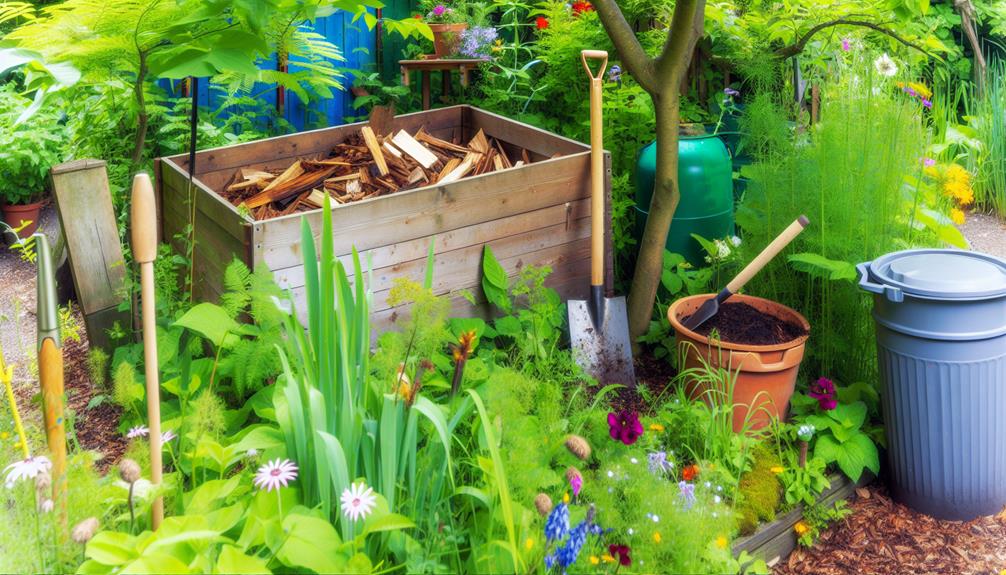

You can compost wood scraps, but you need to be selective and prepare them properly. Choose softwoods like pine and spruce and make sure they’re untreated to avoid harmful chemicals. Break the wood into small pieces to speed up decomposition. Mix these wood chips with nitrogen-rich green materials for balance, and guarantee your compost pile stays moist and aerated.
Avoid using chemically treated lumber and regularly turn the pile to enhance air flow. Composting wood enriches the soil and reduces your carbon footprint. Keep these methods in mind, and you’ll optimize your composting process for better results.
Not all wood scraps are suitable for composting, so it’s important to know which types you can use. First and foremost, you should focus on softwood types and untreated lumber. Softwood, like pine, spruce, and fir, tends to break down more quickly when compared to hardwood, making it a better option for your compost pile.
Untreated lumber is another key consideration. You want to avoid any wood that has been treated with chemicals, paint, or preservatives, as these substances can harm the microorganisms that are essential for the composting process. Stick to wood that’s free from such treatments, ensuring it’s safe for the environment and your compost.
It’s also beneficial to keep an eye out for smaller wood scraps. Large pieces can take a long time to decompose, delaying the overall composting process.
By focusing on softwood types and untreated lumber, you’ll be contributing to a compost pile that’s both efficient and environmentally friendly.
Also Read: Can You Compost Basil?
To prepare wood for composting, start by breaking it down into smaller pieces to speed up the decomposition process. Use tools like a hatchet, saw, or wood chipper for this task. Smaller pieces have more surface area, making it easier for microorganisms to break the wood down.
Before you begin, make sure that the wood hasn’t been treated with chemicals. Wood treatment can introduce toxins into your compost, harming plants and soil life. If you’re unsure, it’s best to avoid composting treated wood altogether.
Different composting methods require different approaches. For traditional compost piles, mix the wood chips with green materials like kitchen scraps and grass clippings. This balance of carbon and nitrogen is important for efficient decomposition. In vermicomposting, avoid adding too much wood, as worms have a harder time breaking it down.
Here’s a quick guide to help you prepare wood for composting:
| Step | Action | Reason |
|---|---|---|
| 1 | Break wood into small pieces | Speeds up decomposition |
| 2 | Check for wood treatment | Avoids introducing toxins |
| 3 | Mix with green materials | Balances carbon and nitrogen |
| 4 | Monitor composting methods | Ensures suitable conditions |
Composting wood not only helps reduce waste but also enriches your soil with valuable nutrients. When you add wood scraps to your compost pile, you’re contributing to soil enrichment by providing essential organic matter that breaks down over time. This process releases nutrients that improve soil structure, water retention, and aeration, making your garden healthier and more productive.

By composting wood, you’re also playing a part in reducing your carbon footprint. Wood scraps that end up in landfills decompose anaerobically, producing methane, a potent greenhouse gas. Composting them instead allows for aerobic decomposition, which notably decreases methane emissions. This small change can make a substantial difference for the environment.
Another benefit is the sense of community and shared responsibility that comes with sustainable practices. When you compost wood, you’re joining a group of like-minded individuals who care about the earth and work towards a greener future. This not only enhances your garden but also strengthens your connection to a broader community of environmentally conscious people.
Also Read: Can You Compost Barbecue Sauce?
To guarantee successful composting of wood scraps, it’s vital to avoid common mistakes that can impede the process and diminish its effectiveness. One significant error is incorporating wood that has chemical contamination. Treated lumber, often used in construction, contains chemicals that can harm your compost and garden. Always use untreated and natural wood scraps.
Here are some common mistakes to avoid:
Also Read: Can You Compost Artichoke?
Enhance your compost pile by incorporating a balanced mix of green and brown materials to optimize decomposition. Green materials, like fruit scraps and grass clippings, provide nitrogen, which is essential for microbial activity. Brown materials, such as dry leaves and wood scraps, add carbon, necessary for energy. This balance is key to a thriving compost system.

To regulate moisture, make sure your pile isn’t too wet or dry. A simple test is to grab a handful of compost and squeeze it. It should feel like a damp sponge. If it’s too dry, add green materials or water. If it’s too wet, mix in more brown materials to absorb excess moisture.
Maintaining nitrogen balance is equally important. Too much nitrogen can create a smelly, anaerobic pile, while too little can slow decomposition. Aim for a ratio of roughly 30 parts brown to 1 part green. By adjusting the mix, you can keep your compost pile healthy and efficient.
Turn your pile regularly to introduce oxygen, which aids decomposition and prevents odor. With these steps, you’ll create a robust compost system, transforming your wood scraps and other waste into valuable, nutrient-rich soil.
You can’t safely compost treated wood due to chemical leaching, which can lead to soil contamination. Stick to untreated wood for your compost pile to keep your garden eco-friendly and safe for everyone in your community.
Wood can take several months to years to decompose in compost, depending on moisture levels and composting conditions. Guarantee a balanced mix and keep everything moist to help your composting community thrive together.
Yes, you should shred wood before composting. It speeds up decomposition, improves compost aeration, and aids moisture management. Shredding makes you part of a community that values efficient, eco-friendly practices. Let’s compost smarter together!
You should avoid treated wood residues and some hardwood varieties like walnut, which can harm your compost. Stick to untreated, natural wood to keep your compost healthy and make sure you’re contributing to a sustainable environment.
You can add sawdust directly to your compost pile, but make sure you maintain proper moisture balance and carbon ratio. Join your fellow composting enthusiasts in creating rich soil by mixing sawdust with green materials for best results.
To sum up, composting wood scraps is a great way to enrich your soil, but you need to do it right. Start by using untreated wood and breaking it down into smaller pieces.
Avoid common mistakes like adding too much at once or using painted wood. By properly preparing and balancing your compost pile, you’ll create nutrient-rich compost that benefits your garden.
Follow these steps, and you’ll make the most of your wood scraps in no time.
